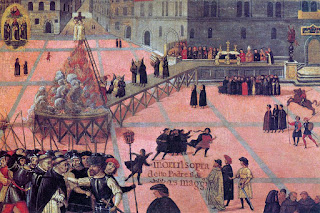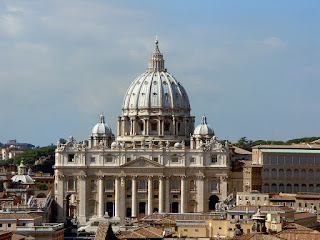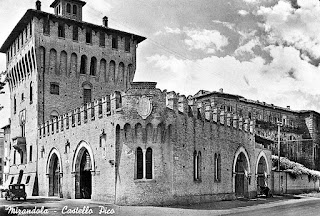Preacher Savonarola's war on Renaissance 'excesses'
 |
| The statue of Girolamo Savonarola in Piazza Savonarola in Florence |
Savonarola campaigned against what he considered to be the artistic and social excesses of the Renaissance, preaching with fanatical passion against any material possession that might tempt the owner towards sin.
He became notorious for organising large communal bonfires in the tradition of San Bernardino of Siena, urging Florentines to come forward with items of luxury or vanity or even simply entertainment that might draw them away from their faith.
Savonarola arrived in Florence from his home town of Ferrara in 1482, entering the convent of St Mark. With Lorenzo de' Medici at the height of his power, Savonarola became disturbed by what he perceived as the moral collapse of the Catholic church.
For a number of years he confined himself to speaking about repentance to congregations of believers in the parishes around Florence but on returning to the city in 1490 he began to campaign with more vigour about what he saw as the need for a return to piety.
He issued dire warnings about what would happen to Florence and its citizens if they did not renounce their sins, prophesising that a powerful leader would arrive from the north to punish Italy and reform the church.
 |
| Paintings by Botticelli were considered indecent under's Savonarola's moral code |
When Emperor Charles VIII of France invaded Italy from the north in 1494, many people saw this as confirmation of Savonarola’s prediction. They rose up against the Medici family, the major sponsors of Renaissance art and literature, and drove them from the city, after which Savonarola became the effective leader of a new Florentine republic.
Savonarola began to host his bonfires in 1495, at around the time that used to be taken up with Carnival celebrations, which he cancelled.
At first, it was items of vanity such as mirrors, cosmetics, jewellery and fine clothes that were thrown on to the flames, along with playing cards, musical instruments and such pagan fripperies as books of magic and astrology. Savonarola employed street urchins to knock on doors, demanding luxurious and suspect items were handed over.
But the scope of what was deemed to be sinful grew. Soon, he was demanding that books he saw as immoral, such as works by Boccaccio, were burned, as well as paintings and sculptures, manuscripts and tapestries. Priceless works by Dante and the Roman poets Ovid and Propertius were said to have been consigned to the flames.
 |
| A painting by an unknown Florentine artist depicts the bonfire built in Piazza della Signoria in which Savonarola was burned |
Already in defiance of a ban on his preaching imposed when he failed to support Pope Alexander's military response to the French invasion, Savonarola was excommunicated in May 1497. The following year, having confessed that his visions and prophecies were invented, he was condemned as a heretic and, with two other friars, hung from a cross in Florence's Piazza della Signoria, to be consumed by a bonfire built beneath him.
A statue of Savonarola, completed in 1875 by the sculptor Enrico Pazzi, from Ravenna, can be found in Piazza Savonarola, about 2km north-east of Florence's centre,
Travel tip:
Florence's Piazza della Signoria has been the focal point of the city since the 14th century. Overlooked by the imposing Palazzo Vecchio, it was the scene of the triumphant return of the Medici family in 1530, three and a half decades after they had been driven from the city by the supporters of the fanatical Savonarola. The controversial priest's bonfires of the vanities were built in the middle of the square, where his own body was burned at the stake in 1498 after he was denounced as a heretic. A marble circle inscription on the piazza shows the spot where he was burned.
Florence hotels from Hotels.com
 |
| The Piazza della Signoria is Florence's main square |
The Piazza della Signoria contains several important sculptures and statues, including a copy of Michelangelo's David - the original is in the Galleria dell'Accademia - outside the Palazzo Vecchio, which is said to be a symbol of defiance against the tyranny of the Medici. The family apparently installed or appropriated their own symbols of power in the shape of Bandinelli's Hercules and Cacus, just to the right of the David, and the Nettuno by Ammannati, which celebrates the Medici's maritime ambitions. Giambologna's equestrian statue of Duke Cosimo I is a tribute to the man who brought all of Tuscany under Medici military rule. Under the Loggia dei Lanzi, to the right of Palazzo Vecchio, the statue of Perseo holding Medusa's head, by Benvenuto Cellini, is a stark reminder of what happened to those who crossed the Medici. Giambologna's Rape of the Sabines can also be found in the Loggia dei Lanzi.
Hotels in Florence from Expedia
More reading:
The execution of Girolamo Savonarola
Sandro Botticelli - Renaissance master forgotten until the 19th century
How scheming Pope Alexander VI married off his children to secure power
Also on this day:
1622: The birth of Vittoria della Rovere, Grand Duchess of Tuscany
1941: The birth in San Marino of pop singer Little Tony
(Picture credits: Savonarola statue by liviathana; Piazza della Signoria by Zolli; via Wikimedia Commons)
(Picture credits: Savonarola statue by liviathana; Piazza della Signoria by Zolli; via Wikimedia Commons)
Home










